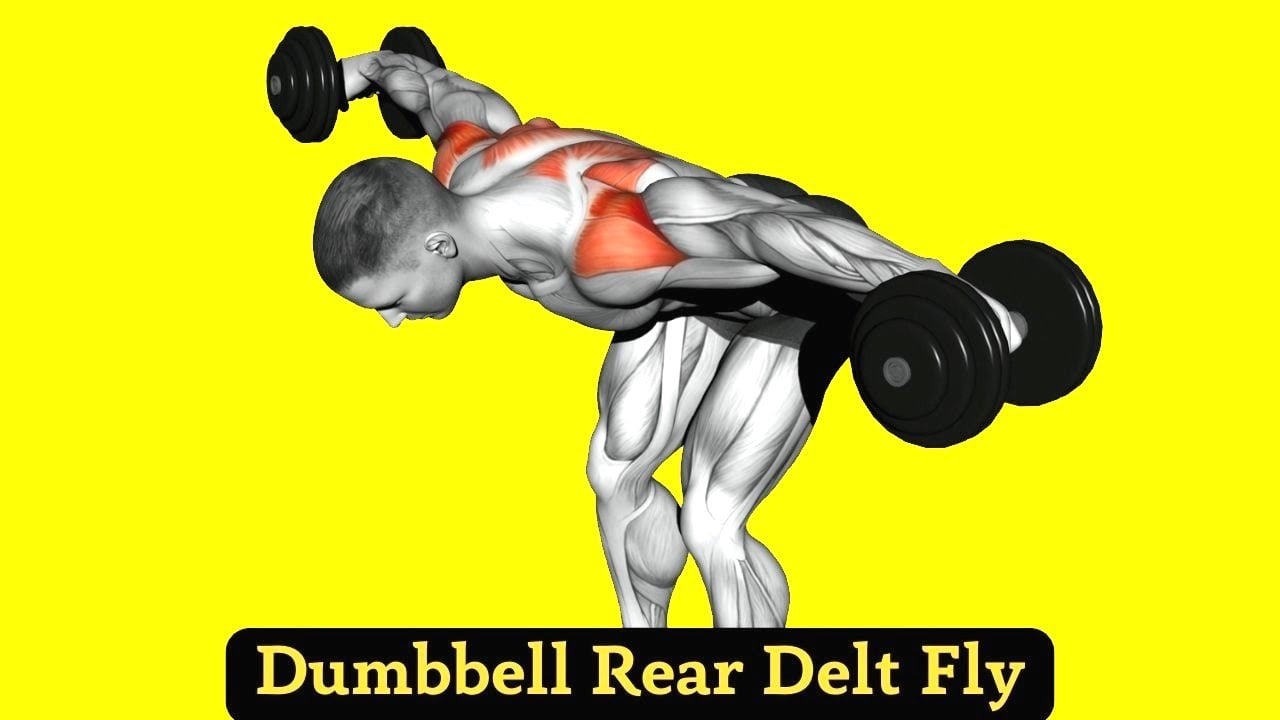The dumbbell rear delt fly is a simple yet effective isolation (single-joint) exercise that increases deltoid muscle definition and strength.
The rear delt dumbbell fly targets your upper back and shoulder muscles, particularly the rear deltoids (the backside of your shoulders).
A strong rear delt muscle helps lifters and bodybuilders build bigger delt muscles. It improves shoulder stability, prevents shoulder injuries, and also helps improve posture by reducing the effect of round shoulders.
However, this exercise can be difficult to perform, especially if you are not familiar with the correct form. That’s where this ultimate guide comes in.
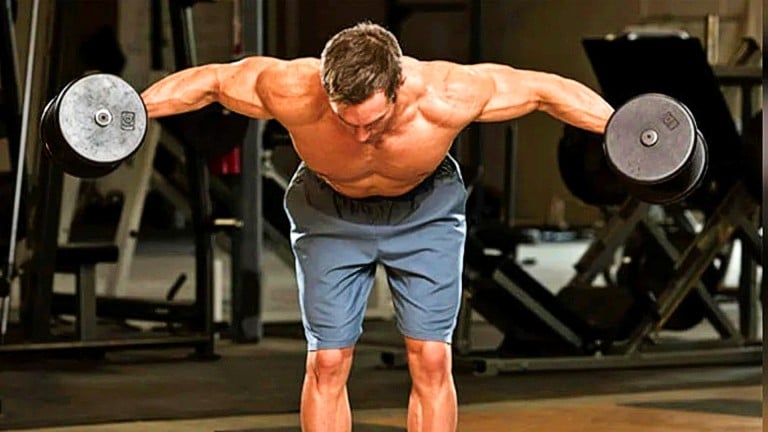
- Dumbbell Rear Delt Fly Muscle Worked
- How To Do Dumbbell Rear Delt Fly
- Tips And Form For Dumbbell Rear Delt Fly
- Best Variations Of Dumbbell Rear Delt Fly
- 1. Seated Dumbbell Rear Delt Fly
- 2. Lying Dumbbell Rear Delt Fly
- 3. Head Supported Rear Dumbbell Fly
- 4. Side-Lying Rear Delt Dumbbell Fly
- How To Do Dumbbell Side-Lying Reverse Fly
- 5. Incline Rear Delt Dumbbell Fly
- 6. Single Arm Dumbbell Rear Delt Fly
- Video illustration of Dumbbell Rear Delt Fly
- References
Dumbbell Rear Delt Fly Muscle Worked
- The rear delt dumbbell flies the primarily worked rear deltoid.
- In addition to its target, the main rear delt muscles, the dumbbell delt fly involves several synergist muscles. These muscles include the rhomboids, Infraspinatus, Teres Minor, and Teres major.
- A handful of other muscles work as stabilizers or play the role of stabilizers, including your Erector Spinae, Lateral Deltoid, Trapezius, Obliques, and Rectus abdominis.
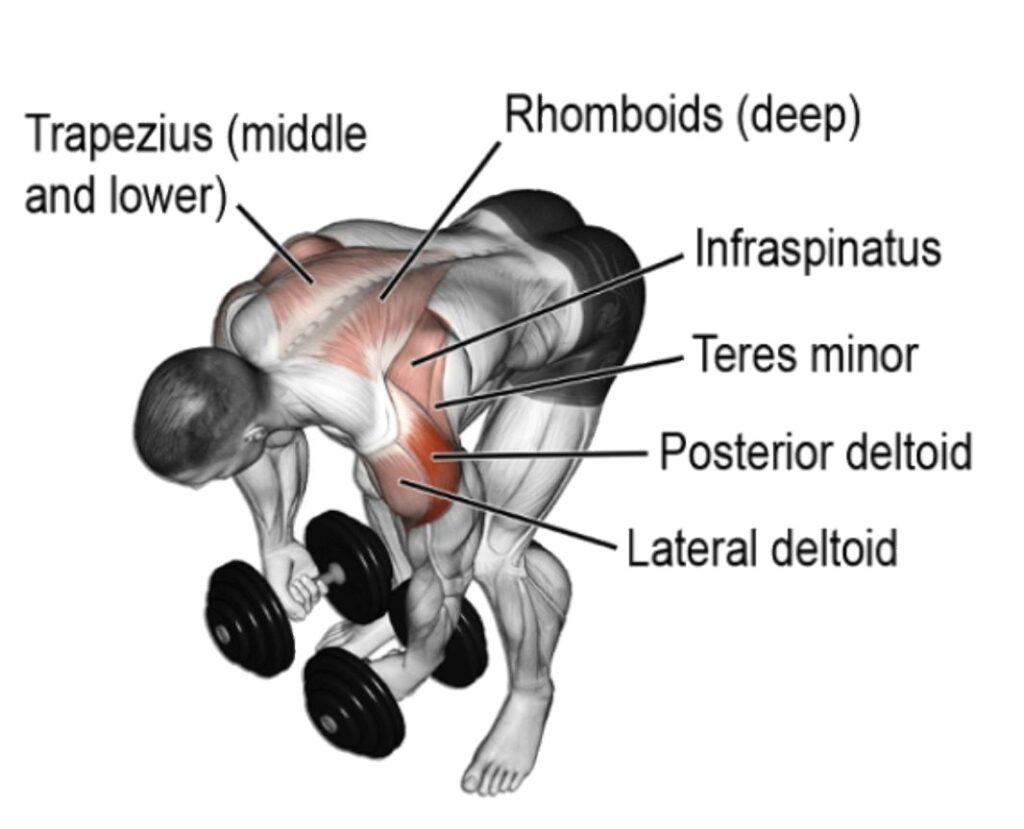
Want to take your gains to the next level? Discover your daily calorie needs with our free TDEE calculator
How To Do Dumbbell Rear Delt Fly
- Stand with your feet shoulder-width apart and a slight bend in your knees.
- Hold a dumbbell in each hand with a neutral grip (palms facing each other).
- Then bend forward at the hips and keep your back straight, like a bent-over row position.
- Your torso should be almost parallel to the floor. Maintain a natural arch in your lower back.
- Engage your core and keep your neck in a neutral position. Your gaze should be towards the floor.
- Keep your elbows slightly bent, and raise both arms out to the sides until the dumbbells are level with the height of your shoulders.
- Your body should resemble the letter ‘T’ at the top of the movement.
- Hold for a count of two and then slowly lower the dumbbells to the starting position in a controlled manner.
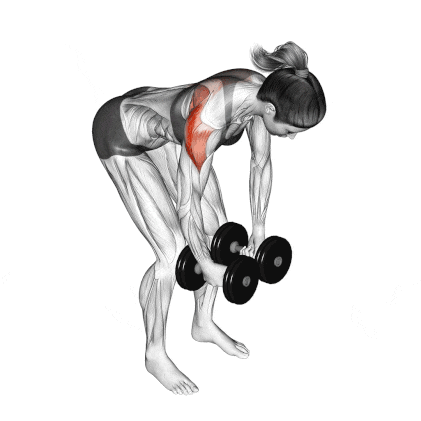
Tips And Form For Dumbbell Rear Delt Fly
- Keep a controlled motion and avoid jerky movements.
- Start with lighter weights to focus on technique and form.
- Throughout the exercise, keep your elbows slightly bent. Avoid fully extending or locking out your elbows.
- Focus on squeezing your shoulder blades together at the peak of the movement to activate your rear deltoid muscles.
- Do the exercise slowly and carefully and focus on the eccentric (lowering) phase.
- Exhale as you pull your arms back, and inhale as you come back. During the exercise, keep your breathing steady.
- Your oblique muscles will need to be engaged to sustain a stable torso throughout the movement.
- As you become more comfortable with the form, change your set and rep ranges to challenge yourself. Common Reps, sets, and frequency for dumbbell rear delt fly.
| Level | Reps | Sets | Frequency |
|---|---|---|---|
| Beginners | 8-10 | 2-3 | 1-2 times per week |
| Intermediate | 10-15 | 3-4 | 2-3 times per week |
| Advanced | 12-15+ | 4-5 | 2-3 times per week |
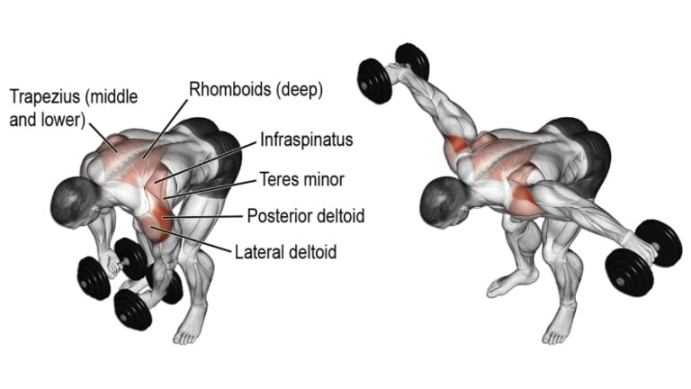
Best Variations Of Dumbbell Rear Delt Fly
It is beneficial to include different variations of the rear delt fly exercise.
- Firstly, you should adjust the position to activate different muscle fibers in the rear deltoids and prevent plateauing. This can result in increased strength and muscle growth.
- Secondly, varying your exercise routine can help prevent boredom and keep your workouts interesting and challenging.
- Finally, do different versions of the rear delt fly to work different muscles instead of just one.
1. Seated Dumbbell Rear Delt Fly
The seated dumbbell rear delt fly is a variation of the traditional dumbbell delt fly, performed while sitting down instead of standing.
Thus, the exercise hit specifically the rear shoulder head by isolating it better than any other shoulder exercise.
Adding seated exercises to your routine will provide a different stimulus and help you break down plateaus. It also benefits people who have difficulty maintaining proper form while standing.

How To Do Dumbbell Seated Rear Delt Fly
- Sit on a bench or chair with your feet firmly planted.
- Hold a dumbbell in each hand, keeping your palms facing inwards.
- Lean forward from your hips while maintaining a straight back, allowing your arms to hang down toward the floor.
- Slightly bend your elbows and raise your arms out to the sides in a wide arc.
- Continue the movement until your upper arms parallel the floor or slightly higher.
- Then, slowly lower the dumbbells back to their starting position.
2. Lying Dumbbell Rear Delt Fly
If the traditional dumbbell rear fly causes strain on your lower back, try using a lying rear delt fly.
Instead of relying on your core to stabilize your body, you can rest on the bench, which will help to isolate your rear deltoids better.
When done correctly, it can effectively target the upper body including your neck, shoulders, and upper back.
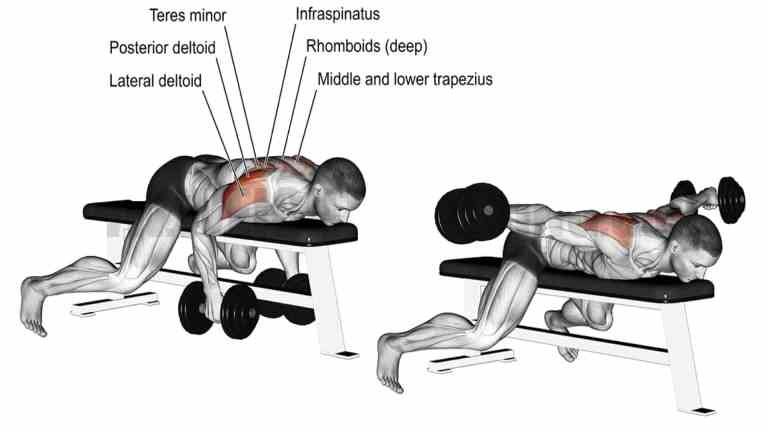
How To Do Dumbbell Lying Rear Delt Fly
- Place two dumbbells on the floor, one on each side of a flat bench.
- Lie prone (on your front) on the bench and grasp a dumbbell in each hand.
- Spread your legs on the floor for support.
- Keep your elbows slightly bent and elevate both arms to the sides until the dumbbells reach the same height as your shoulders.
- Hold the dumbbells for two seconds and then slowly lower them back to where they started.
3. Head Supported Rear Dumbbell Fly
When you support your head on the incline bench, it provides stability for the head and neck and allows you to focus more on the rear deltoid contraction.
As you become more upright in your torso, you will place more emphasis on your lateral deltoids instead of on your posterior deltoids.
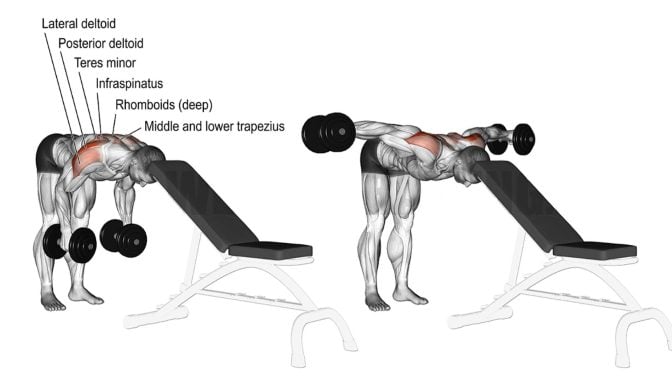
How To Do Head-Supported Rear Delt Dumbbell Fly
- First, find a nice incline bench and adjust it to a height that feels good for your hips or is comfortable.
- Next, grab a dumbbell in each hand, bend at the hips, and rest your forehead on the edge of the bench.
- Make sure your back is straight, and let your arms hang in front of you with your palms facing inward.
- Now, bend your elbows slightly and lift both arms out to the sides until the dumbbells align with your shoulders.
- Hold that position for a couple of seconds, then slowly lower the dumbbell back down to the starting position.
4. Side-Lying Rear Delt Dumbbell Fly
It is a great unilateral exercise used to target a smaller and often lagging muscle group. Instead of lying on the floor, you can lie on a bench.
Furthermore, the side-lying rear delt fly helps to strengthen the rotator cuff muscles, which are essential for maintaining optimal shoulder health.

How To Do Dumbbell Side-Lying Reverse Fly
- Lie on your side on a mat or bench, with your legs stacked on top of each other and your head supported by your lower arm.
- Grasp the dumbbell with your left hand using a neutral grip (palm facing downward).
- Lift the dumbbell up and away from your body with a slight bend in your elbow.
- Hold for a count of two at the top of the movement.
- Then, reverse the movement and lower the dumbbell towards the starting position, stopping before it touches the floor.
- Repeat the exercise on the opposite side with your right arm.
5. Incline Rear Delt Dumbbell Fly
Incline rear Delt Dumbbell Fly, also known as chest-supported dumbbell fly, reduces the potential for using momentum and makes it more challenging.
It allows for a greater range of motion than standing variations, resulting in a deeper stretch and better muscle activation.
It provides many other benefits, such as adding size and strength to the posterior, lateral deltoids, and trap muscles.

How To Do Chest-Supported Rear Delt Dumbbell Fly
- Set up an incline bench at a 45-degree angle.
- Sit on the incline bench with your feet firmly planted on the ground.
- Hold the dumbbells so that they hang straight down from your shoulders.
- Slowly lift the dumbbells up and out to the sides of your body, pulling through the rear delts and middle traps.
- Pause for a moment at the top of the motion before slowly lowering the weights back down to the starting position.
6. Single Arm Dumbbell Rear Delt Fly
If you do the exercise with just one arm at a time, you can focus on the rear deltoid muscle better. This will help you work out the muscles more efficiently.
Single arm exercises challenge your core stability and balance, while working your back muscles.
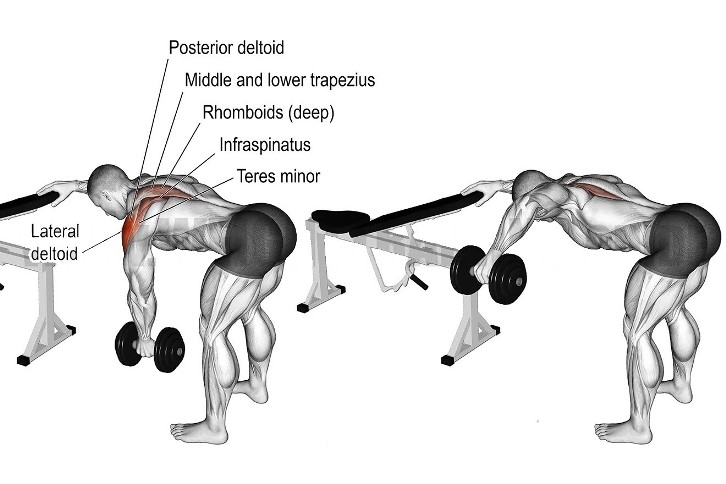
How To Do One-Arm Dumbbell Rear Delt Fly
- Stand with your feet shoulder-width apart, holding a dumbbell in one hand.
- Bend your knees slightly and hinge forward at the hips.
- Let the dumbbell hang towards the floor, and ensure your arm is fully extended.
- Lift the dumbbell out to the side in a wide arc with a slight bend in your elbow
- At the top of the movement, pause for a moment, and then slowly lower the dumbbell back down.
- Complete the desired number of repetitions on one side, then switch to the other side and repeat.
Video illustration of Dumbbell Rear Delt Fly
References
- Atalay E, Akova B, Gür H, Sekir U. Effect of upper-extremity strengthening exercises on the lumbar strength, disability and pain of patients with chronic low back pain: a randomized controlled study. J Sports Sci Med. 2017;16(4):595-603. PMID:29238262

Manish is a NASM-certified fitness and nutrition coach with over 10 years of experience in weight lifting and fat loss fitness coaching. He specializes in gym-based training and has a lot of knowledge about exercise, lifting technique, biomechanics, and more.
Through “Fit Life Regime,” he generously shares the insights he’s gained over a decade in the field. His goal is to equip others with the knowledge to start their own fitness journey.

